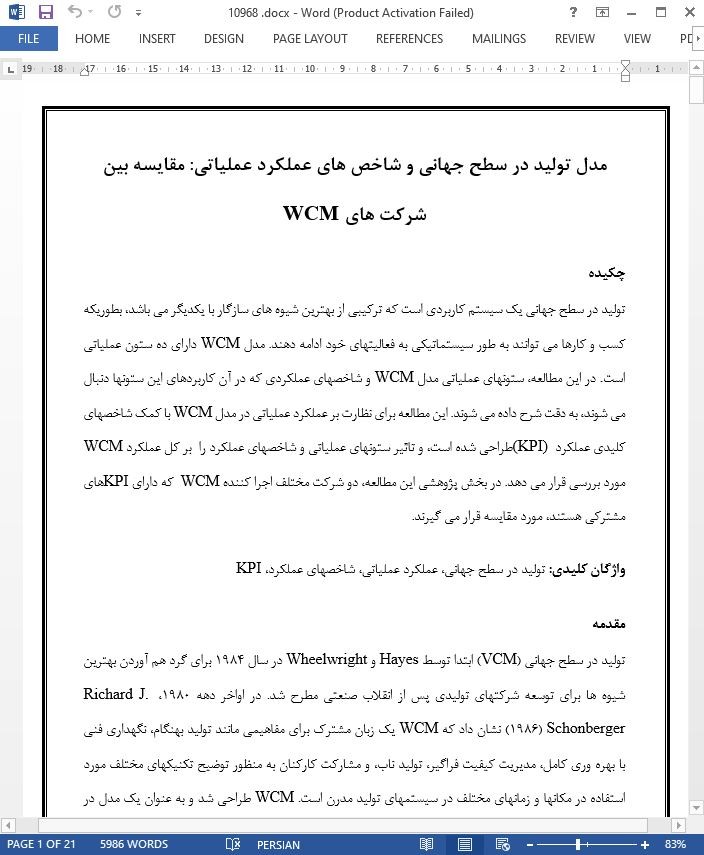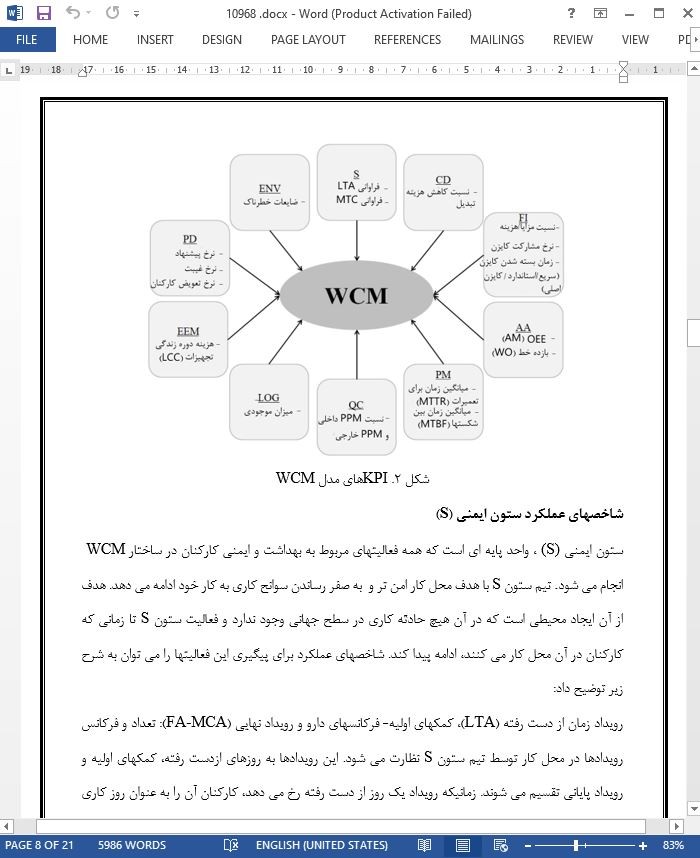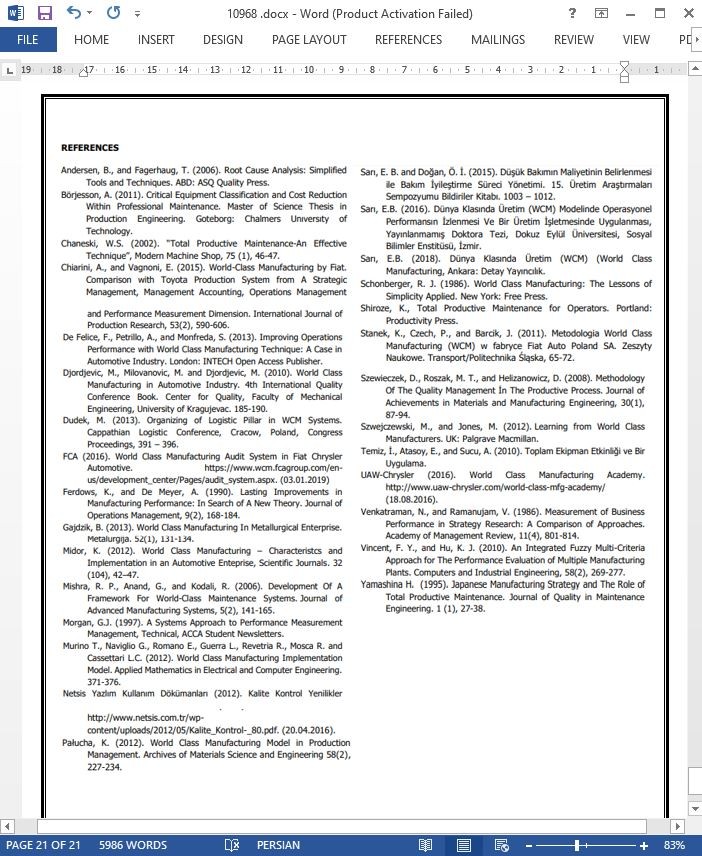
مدل تولید در سطح جهانی و شاخص های عملکرد عملیاتی
چکیده
تولید در سطح جهانی یک سیستم کاربردی است که ترکیبی از بهترین شیوه های سازگار با یکدیگر می باشد، بطوریکه کسب و کارها می توانند به طور سیستماتیکی به فعالیتهای خود ادامه دهند. مدل WCM دارای ده ستون عملیاتی است. در این مطالعه، ستونهای عملیاتی مدل WCM و شاخصهای عملکردی که در آن کاربردهای این ستونها دنبال می شوند، به دقت شرح داده می شوند. این مطالعه برای نظارت بر عملکرد عملیاتی در مدل WCM با کمک شاخصهای کلیدی عملکرد (KPI) طراحی شده است، و تاثیر ستونهای عملیاتی و شاخصهای عملکرد را بر کل عملکرد WCM مورد بررسی قرار می دهد. در بخش پژوهشی این مطالعه، دو شرکت مختلف اجرا کننده WCM که دارای KPIهای مشترکی هستند، مورد مقایسه قرار می گیرند.
مقدمه
تولید در سطح جهانی (VCM) ابتدا توسط Hayes و Wheelwright در سال 1984 برای گرد هم آوردن بهترین شیوه ها برای توسعه شرکتهای تولیدی پس از انقلاب صنعتی مطرح شد. در اواخر دهه 1980، Richard J. Schonberger (1986) نشان داد که WCM یک زبان مشترک برای مفاهیمی مانند تولید بهنگام، نگهداری فنی با بهره وری کامل، مدیریت کیفیت فراگیر، تولید ناب، و مشارکت کارکنان به منظور توضیح تکنیکهای مختلف مورد استفاده در مکانها و زمانهای مختلف در سیستمهای تولید مدرن است. WCM طراحی شد و به عنوان یک مدل در سال 2006 مورد استفاده قرار گرفت تا بر بحران گروه فیات کرایسلر اتومبیلز (FCA) غلبه نماید. مدل VCM بر مبنای بدون عدم وجود ضایعات، عدم وجود نقص، عدم صورت کالا و عدم شکست می باشد.
نتیجه گیری
مدل WCM، یک مدل پویا، همواره در حال تکامل و خود-تجدیدکننده است. نظارت بر عملکرد WCM با پیگیری این تغییر نیز انجام می شود. مدل WCM دارای مقادیر مختلف KPI است که باید توسط کاروران در جریان اسلوب سازی دنبال شود و دارای سه مرحله می باشد. نتیجه نشان می دهد که مدل WCMتغییر را می پذیرد و مدل را برای مراحلی که بارها و بارها تکرار می شوند حفظ می کند تا سطوح تاثیر آن را مشخص کند.
تولید در سطح جهانی، تلاشی برای یک عامل است تا به ارکان سه گانه توسعه پایدار که تحت تاثیر نوآوریها و تغییر در فن آوری قرار دارد، برسد و بطور مداوم به بهترین نتیجه دست یابد. این تغییر همچنان در کاری که باید بر روی مدل WCM انجام شود ادامه خواهد یافت تا بر تغییر در عملکرد شرکتهایی که مدل WCM را اجرا می کنند، نظارت انجام شود. هر کسب و کاری باید دارای ویژگیهای متفاوت و منحصر به فردی باشد تا بتواند در فرایندهای خود به کمال برسد و خود را به عنوان یک فلسفه تجدید کننده بپذیرد.
ABSTRACT
World Class Manufacturing is an application system that combines best practices which are compatible with each other so that businesses can continue their activities systematically. WCM model has ten operational pillars. In this study, the operational pillars of the WCM model and the performance indicators in which the applications of these pillars are followed are elaborated. The study was designed to monitor operational performance in the WCM model with the help of Key Performance Indicators (KPI) and investigate the effects of operational pillars and performance indicators on total WCM performance. In the research part of the study, two different WCM operator firms are compared and their KPIs are shared.
INTRODUCTION
World Class Manufacturing (WCM) was first proposed by Hayes and Wheelwright in 1984 to bring together the best practices for the development of manufacturing enterprises after the industrial revolution. In the late 1980s, Richard J. Schonberger (1986) showed that WCM is a common language for concepts such as just-in-time, total productive maintenance, total quality management, lean manufacturing and employee involvement in order to explain the different types of techniques used in different places at different times in modern production systems. WCM was developed and used as a model in 2006 to overcome the crisis in the Fiat Chrsyler Automobile (FCA) Group. WCM model is based on zero waste, zero defects, zero inventories and zero failure.
CONCLUSION
The WCM model is a dynamic, constantly evolving, self-renewing model. Monitoring of WCM performance is also carried out by following this change. The WCM model will have varying KPI values that must be followed by the practitioner in the course of the systemization followed by the three phases. The result from this is that the WCM model accepts the change and maintains the model for the phases it is going through again and again in order to determine the impact levels. World Class Manufacturing is a quest for an operator to reach the bottom line, to be influenced by innovations and changes in technology, and to achieve the best continuously. This change will continue to follow the change in work to be done on the WCM model in order to monitor this change-over performance of enterprises implementing the WCM model. Every business has to have different and unique characteristics, to try to catch perfection in its processes and to accept itself as a philosophy of renewing.
چکیده
مقدمه
مدل تولید در سطح جهانی (WCM)
شاخصهای عملکرد عملیاتی در مدل تولید در سطح جهانی
شاخصهای عملکرد ستون ایمنی (S)
شاخصهای عملکرد ستون توزیع هزینه (CD)
شاخصهای عملکرد ستون بهبود متمرکز (FI)
شاخصهای عملکرد ستون فعالیتهای مستقل (AA)
شاخصهای عملکرد ستون تعمیرات و نگهداری مستقل (AM)
شاخصهای عملکرد ستون سازماندهی محل کار (WO)
شاخصهای عملکرد ستون تعمیرات و نگهداری حرفه ای (PM)
شاخصهای عملکرد ستون کنترل کیفیت (QC)
شاخصهای عملکرد ستون لجستیک (LOG)
شاخصهای عملکرد ستون مدیریت تجهیزات اولیه (EEM)
شاخصهای عملکرد ستون توسعه افراد
شاخصهای عملکرد ستون محیط (ENV)
ارزیابی شرکتهای WCM
نتیجه گیری
ABSTRACT
INTRODUCTION
WORLD CLASS MANUFACTURING (WCM) MODEL
OPERATIONAL PERFORMANCE INDICATORS IN THE WORLD CLASS MANUFACTURING MODEL
Safety (S) Pillar Performance Indicators
Cost Deployment (CD) Pillar Performance Indicators
Focused Improvement (FI) Pillar Performance Indicators
Autonomous Activities (AA) Pillar Performance Indicators
Autonomous Maintenance (AM) Pillar Performance Indicators
Workplace Organization (WO) Pillar Performance Indicators
Professional Maintenance (PM) Pillar Performance Indicators
Quality Control (QC) Pillar Performance Indicators
Logistics (LOG) Pillar Performance Indicators
Early Equipment Management (EEM) Pillar Performance Indicators
People Development (PD) Pillar Performance Indicators
Environment (ENV) Pillar Performance Indicators
BENCHMARK OF WCM FIRMS
CONCLUSION
- اصل مقاله انگلیسی با فرمت ورد (word) با قابلیت ویرایش
- ترجمه فارسی مقاله با فرمت ورد (word) با قابلیت ویرایش، بدون آرم سایت ای ترجمه
- ترجمه فارسی مقاله با فرمت pdf، بدون آرم سایت ای ترجمه



